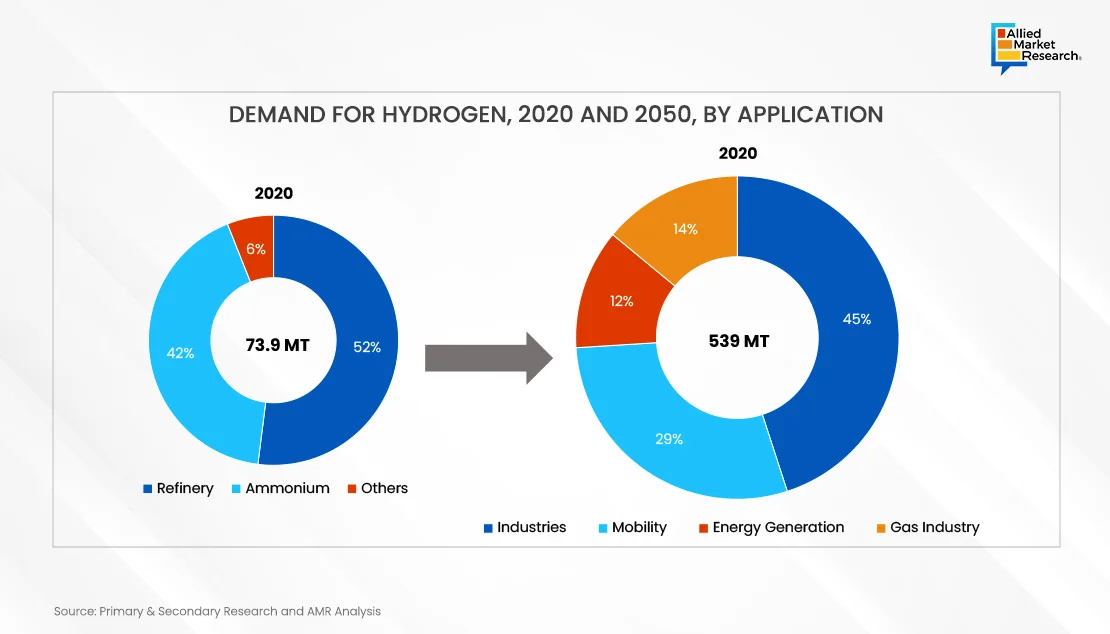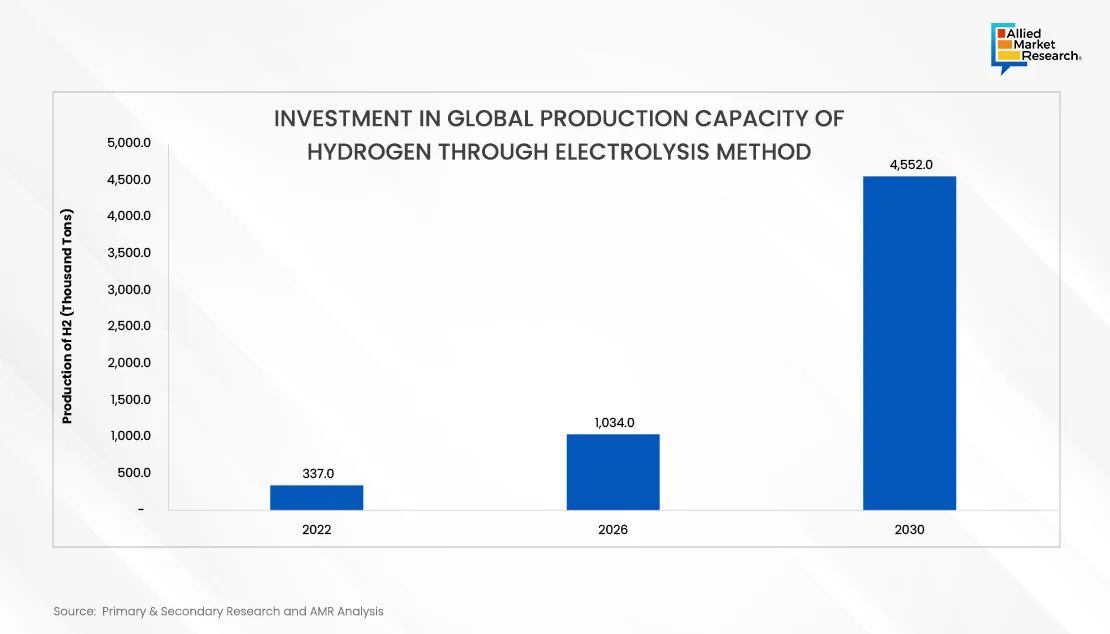Table Of Contents

Yerukola Eswara Prasad

Pooja Parvatkar
Hydrogen Industry Trends to Lookout for in 2024

In the past, hydrogen was used in very few applications such as in crude oil refinery, ammonium production, glass purification, fertilization production and others. However, in the present situation hydrogen is utilized in sectors such as transportation, industry, power generation, and many more. Hydrogen is a versatile energy carrier due to which it holds great potential for a wide range of applications, particularly in the transition to a low-carbon economy.

Overall, the hydrogen industry is poised for expansion as countries aim to transition to low-carbon energy systems and achieve climate goals. According to a study by Allied Market Research, The global hydrogen generation market size was valued at $136.3 billion in 2021, and hydrogen generation industry is projected to reach $262.0 billion by 2031, growing at a CAGR of 6.8% from 2022 to 2031 (https://www.alliedmarketresearch.com/hydrogen-generation-market).Companies are engaged in the production of hydrogen through various methods, including steam methane reforming (SMR), electrolysis (using electricity to split water into hydrogen and oxygen), biomass gasification, and thermochemical processes.
Hydrogen is produced from different processes; however, green hydrogen which is produced through the electrolysis process is expected to dominate the hydrogen industry in the coming years. Green hydrogen, which is produced via electrolysis powered by renewable energy, is gaining attention as a sustainable and carbon-free option. Furthermore, ongoing research, investments, and collaborations in development of new technologies to produce green hydrogen are expected to further accelerate the development and adoption of hydrogen technologies worldwide.

New Technology for Green Hydrogen Production
| New Technology | Sub Type | Description |
| Solar-Driven Hydrogen Production Technologies |
| Solar-driven hydrogen production technologies utilize solar energy to generate hydrogen through various processes. Green hydrogen is produced from solar-driven hydrogen production technologies. Solar panels capture sunlight and convert it into electricity, which is then used in the electrolysis process to split water (H2O) into hydrogen (H2) and oxygen (O2) These technologies leverage sunlight as a renewable energy source to power reactions that produce hydrogen, a clean and versatile fuel. |
Solar-driven hydrogen production technologies harness the power of sunlight to generate hydrogen gas through various processes:
Photovoltaic Electrolysis (PV-E) utilizes photovoltaic (PV) cells to directly convert solar energy into electricity. The electricity generated is then used to power an electrolyzer, which splits water (H2O) into hydrogen (H2) and oxygen (O2) through electrolysis. PV-E systems are modular and scalable, making them suitable for distributed hydrogen production.
Photoelectrochemical (PEC) Water Splitting systems use semiconductor materials to absorb sunlight and catalyze the water-splitting reaction. When sunlight strikes the semiconductor surface, it creates electron-hole pairs, which drive the electrolysis of water. PEC systems may achieve higher efficiencies compared to traditional PV-E systems due to direct conversion of solar energy into chemical energy.
New use cases of Hydrogen
| S.no | New use case | Application | Description |
| 1 | Transportation | Fuel Cell Vehicles (FCVs) | Hydrogen may be used as a fuel for fuel cell vehicles. In FCVs, hydrogen reacts with oxygen in a fuel cell to produce electricity, powering the vehicle's electric motor. This offers a clean and efficient alternative to traditional internal combustion engine vehicles. |
| 2 | Power Generation | Stationary Fuel Cells | Hydrogen may be used in stationary fuel cells for power generation. This is particularly useful in applications where a decentralized and reliable power source is needed, such as in remote areas or as a backup power supply for critical infrastructure. |
| 3 | Industrial Processes | Hydrogen as a Feedstock | Hydrogen is a crucial feedstock for various industrial processes, including the production of ammonia, methanol, and other chemicals. It is an essential component in the chemical industry and serves as a building block for many products |
| 4 | Energy Storage | Hydrogen Energy Storage | Hydrogen may be used as a means of energy storage. Excess electricity generated from renewable sources may be used to produce hydrogen through electrolysis, and the stored hydrogen may later be converted back to electricity when needed. |
| 5 | Grid Balancing | Renewable Integration | Hydrogen may play a role in balancing the variability of renewable energy sources. Excess renewable energy, during times of high generation, may be used to produce hydrogen, and the stored hydrogen may be utilized during periods of low renewable generation. |
| 6 | Residential Heating | Hydrogen Boilers | Hydrogen may be used as a fuel for residential heating systems, replacing natural gas. Hydrogen boilers produce heat through combustion, emitting only water vapor as a byproduct |
| 7 | Aviation | Hydrogen-Powered Aircraft | Hydrogen has the potential to be used as a clean fuel for aviation. Research and development are ongoing to explore the feasibility of hydrogen-powered aircraft, offering a low-carbon alternative to traditional jet fuels |
| 8 | Maritime Applications | Hydrogen-Powered Ships | Hydrogen fuel cells may be employed in maritime transport to power ships, reducing emissions in the shipping industry. This is particularly relevant as the maritime sector seeks sustainable alternatives to traditional fuels. |
The utilization of hydrogen as a fuel for automotive applications has been a significant driver of growth in the hydrogen market, both presently and in the foreseeable future. Presently, hydrogen is used as a fuel for fuel cell vehicles (FCVs). These vehicles use hydrogen gas to generate electricity through fuel cells, which then power electric motors to drive the vehicle. FCVs offer several advantages such as longer driving ranges and shorter refueling times compared to battery electric vehicles (BEVs). Furthermore, several countries and regions, such as Japan, California, and parts of Europe, have initiated programs to deploy FCVs and develop hydrogen refueling infrastructure which drive the demand for use of hydrogen in the automotive sector. Continued investment in hydrogen refueling infrastructure is expected to support the growth of FCV adoption, enabling consumers to refuel their vehicles conveniently.
Developing countries are investing in research and development activities focused on improving hydrogen fuel cell technology, making FCVs more cost-effective, efficient, and suitable for mass adoption. Government incentives, subsidies, and regulations promoting zero-emission vehicles are expected to further drive the growth of hydrogen fuel cell vehicles in the automotive market.
In the power generation sector, hydrogen may be used to generate electricity through fuel cells or by burning it in gas turbines. This enables the production of clean electricity without greenhouse gas emissions. Hydrogen may be utilized in combined heat and power (CHP) systems, where the waste heat from electricity generation is captured and used for heating purposes in residential and commercial buildings.
Key market players are increasingly investing in the hydrogen market due to its potential to address energy challenges and drive sustainability.
- Toyota Motor Corporation: Toyota has been a pioneer in hydrogen fuel cell technology, with its Mirai fuel cell vehicle. The company has been investing in expanding its hydrogen infrastructure and collaborating with other stakeholders to promote hydrogen adoption.
- Hyundai Motor Company: Hyundai has launched hydrogen fuel cell vehicles such as the Nexo SUV and has plans to expand its lineup. The company is investing in hydrogen production technologies, infrastructure development, and partnerships to support the growth of the hydrogen economy.
- Ballard Power Systems: Ballard is a leading provider of proton exchange membrane (PEM) fuel cell technology. The company is involved in developing fuel cell systems for various applications, including transportation, backup power, and material handling equipment.
- Air Liquide: Air Liquide is one of the world's largest industrial gas companies and a major player in the hydrogen market. The company is investing in hydrogen production, storage, and distribution infrastructure, as well as fueling stations for hydrogen-powered vehicles.
- Plug Power: Plug Power specializes in hydrogen fuel cell systems for material handling equipment and other industrial applications. The company is expanding its offerings to include hydrogen fueling infrastructure for both industrial and transportation sectors.
- Shell: Shell is actively investing in hydrogen projects, including production, distribution, and fueling infrastructure. The company is exploring opportunities in hydrogen production from renewable sources and integrating hydrogen into its energy portfolio.
- TotalEnergies: TotalEnergies is diversifying its energy portfolio to include hydrogen as a low-carbon energy carrier. The company is investing in electrolysis projects, hydrogen production facilities, and partnerships to promote hydrogen adoption in transportation and industry.
- Nel ASA: Nel ASA is a leading provider of electrolyzer technology for hydrogen production. The company is involved in developing large-scale electrolysis projects, hydrogen refueling stations, and renewable hydrogen solutions.
A Promising Energy Source of the Future
Hydrogen holds great promise as a clean, versatile, and sustainable energy source for the future. With its zero-emission characteristics and various applications across industries, hydrogen may significantly contribute to global efforts in mitigating climate change and achieving a low-carbon economy. Hydrogen has the potential to transform the energy landscape. Players in the hydrogen industry are investing in various aspects of the hydrogen value chain, from production and distribution to fuel cell technology and infrastructure, driving innovation and growth in the hydrogen market. Hydrogen produced from renewable resources is used in various industries, which is expected to drive its demand in the coming future. Government initiatives and international cooperation further demonstrate the commitment to harnessing the power of hydrogen. The hydrogen industry is set to grow exponentially, transforming the way of production, distribution, and paving the way for a greener & more sustainable future. To dive deeper into the industry, get in touch with AMR analysts.

